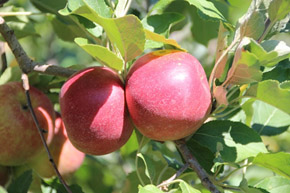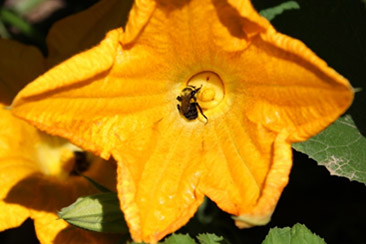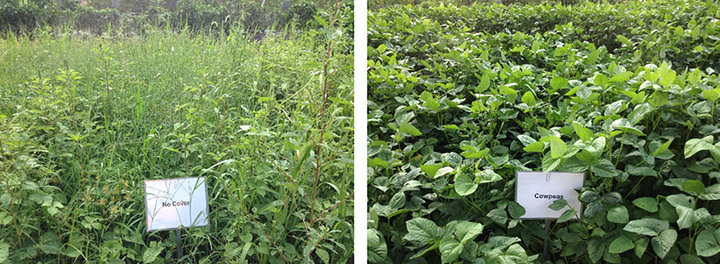Address any questions or comments regarding this newsletter to the individual authors listed after each article or to its editors, Nathan Johanning, 618-939-3434, njohann@illinois.edu or Bronwyn Aly 618-695-6060, baly@illinois.edu. The Illinois Fruit and Vegetable News is available on the web at: http://ipm.illinois.edu/ifvn/. To receive or be removed from email notification of new postings of this newsletter, contact Nathan Johanning or Bronwyn Aly at the phone numbers or email addresses above.
In This Issue:
Upcoming Programs (listings for beginning and established growers)
News & Announcements (Fruit & Vegetable Research Priorities Survey, NASS Fruit Production Forecasts Released)
Regional Reports (north central Illinois, St. Louis Metro-east, southern Illinois)
Fruit and Vegetable Production and Pest Management (Late Season Weed Management)
Upcoming Programs
Check the Illinois SARE calendar for a full list of programs and links for registration.
http://illinoissare.org/ and http://illinoissare.org/calendar.php
Also see the University of Illinois Extension Local Food Systems and Small Farms Team's website at:
http://web.extension.illinois.edu/smallfarm/ and the calendar of events at http://web.extension.illinois.edu/units/calendar.cfm?UnitID=629.
- Vegetable Field Day, Thursday, August 17, 2017, 1:30 – 3:00 p.m. U of I Vegetable Crops Research Farm, 2921 S First St. Champaign, IL 61822. For more information contact Mohammad Babadoost at 217-333-1523 or babadoos@illinois.edu.
- Pumpkin Field Day, Friday, September 1, 2017 1:00 – 4:30 p.m. Dollinger Farm 7420 E. Hansel Rd. Channahon, IL. Learn about varieties of choice, garden preparation, irrigation, weeding, disease and insect pest management, and economics. University of Illinois educators will be on hand to offer technical advice. Company representatives from Rupp Seeds and Rispen Seeds will talk about their entries that will be growing in plots. To register for this free event, or for more information, contact James Theuri at 815-933-8337 or jtheu50@illinois.edu
- Twilight Tours: Knowlan Family Farm. Wednesday, September 6, 2017, 6 – 8 p.m. 3243 St. Hwy 34 Burfordville, MO. http://extension.missouri.edu/stegenevieve/documents/KnowlanOrchard2017.pdf The program is $5 and pre-registration is required. To register or for more information, call 573-238-2420 or email aufdenbergd@missouri.edu
- Midwest Mechanical Weed Control Field Day, Tuesday, September 26, 2017, 10 a.m.- 5 p.m. Michigan State University Horticulture Farm, 3291 College Rd, Holt, MI. From finger weeders to flex-tines to Allis G's and beyond, come learn the principles and tools for precise mechanical weed control from farmers and researchers. New weeding machines are recently available from Europe and many types and models of mechanical weeders will be on display and demonstrated in the field. You will hear from farmers using these tools, learn about cultivation techniques in Europe, see tools demonstrated, and enjoy lunch and time to speak with all the growers in attendance. Register online at Midwest Mechanical Weed Control Field Day, or contact Sam Hitchcock Tilton at 414-213-5337 or hitchc32@msu.edu
- 2018 Gateway Small Fruit & Vegetable Conference, Wednesday, February 7, 2018. Regency Conference Center, O'Fallon, IL. Save the date; more details closer to the event. For more information contact Elizabeth Wahle at wahle@illinois.edu or 618-344-4230.
News & Announcements
Fruit and Vegetable Research Priorities Survey
This survey was compiled by Elizabeth Wahle, Nathan Johanning, and Bronwyn Aly with the purpose of accessing the research needs on vegetable, high tunnel, and fruit production in Illinois. By prioritizing and focusing on specific areas identified by specialty crops growers and industry professionals, the University of Illinois can work with the industry to target those research needs. This survey is not intended to be a list of crops you are currently growing, but rather, a mechanism to provide direction to future research endeavors. Your input will directly influence the direction of future applied specialty crop research! Please take 5 minutes to fill out the survey by clicking on the following link: Fruit and Vegetable Research Priorities If you have specific comments or thoughts regarding research focus areas not addressed by the survey, please feel free to contact Elizabeth, Nathan, or Bronwyn at your convenience (see the contact list at the end). Thank you for your feedback!
Bronwyn Aly (618-382-2662; baly@illinois.edu)
NASS Fruit Production Forecasts Released
The National Agricultural Statistics Service (NASS) fruit production forecasts that were published last week. See pages 26 and 27 in this document: http://usda.mannlib.cornell.edu/usda/current/CropProd/CropProd-08-10-2017.pdf
Mark Schleusener, Illinois State Statistician, USDA-NASS (217-524-9606; mark.schleusener@nass.usda.gov)
Regional Reports
From north central Illinois... A break in the heat has yielded a mild August. However, I don't put it past Mother Nature to wait until school starts and then crank the heat back up. Rainfall amounts are well above July, and it's only August 14 as I'm writing this, with chances of rain in the forecast nearly every day this week.
Despite hearing many reports of slow to ripen tomatoes, our plants in Macomb have kept up a good pace, and the somewhat cooler weather has not slowed down our tomato picking. In mid-July, scouting revealed the beginning of tomato hornworm damage. After a treatment of BtK, I've yet to see any more evidence of this pest.
Tomorrow we'll begin pulling summer crops out and plant carrots and turnips in two beds. Meanwhile, our three remaining beds currently in tomatoes, peppers, beans, and cukes, will be sowed with a fall cover crop.
Head lettuces, cabbage, kale, broccoli, and bok choi have been planted in flats, and I was excited to see germination of several types.
The high tunnel has been mostly cleaned out. I harvested worm castings out of my worm bin and side dressed the ginger, turmeric, and hops earlier this summer. The ginger and turmeric plants are now established and have finally begun putting out healthy growth.
The Cascade hops are nearly there. This week the drying rack will be rebuilt, and harvest likely to occur this weekend. The hops grew quite well this year, despite the invasion of Japanese beetles that stripped the top half of the bines.
U-pick orchards and agritourism destinations need to scout for yellowjacket nests and take control measures before the crowds start showing up. Yellowjackets become more aggressive late in the season due to a lack of nectar food sources. Dropped fruit on the orchard floor or open soda cans can be very inviting. Traps are available for purchase, or you can make your own. Place traps away from gathering areas to draw foragers away from visitors. The eXtension website has an IPM action plan for yellowjackets.
Chris Enroth (309-837-3939; cenroth@illinois.edu)

Jonathan apple coloring nicely but
not quite ripe. Photo. E. Wahle
From the St. Louis Metro-East... Kids going back to school traditionally signals the transition from peach to apple harvest. This week Cresthaven peaches along with Gala and Honeycrisp apples are in harvest. Next up in peaches will be Encore followed by Laurol. Jonathan apple harvest is just around the corner. Grape harvest is also ramping up. Cultivars like Seyval and Vignole are in the cue and are being closely monitored for optimal berry chemistry and taste profile while staying ahead of damaging rain fronts. Not all grapes are susceptible to cracking after rain and various bunch rots, just those that are thin skinned and/or tight clustered. Vidal blanc for example is relatively thick-skinned and does not suffer the same weather-related problems. Plasticulture strawberry growers are prepping for an early fall planting. Those still fumigating already have plastic down, just waiting for the pre-plant interval restriction on the fumigant to pass before planting.

A bumblebee species receiving a sugary
reward from a pumpkin flower nectary
in exchange for its pollinating services.
Photo: E. Wahle
Blackberries are in the final week of harvest. Vegetables are still in full harvest, including pole beans, kale, cucumbers, zucchini, tomatoes, peppers and sweet corn just to name a few. With cooler evening temperatures, pumpkin vines have ramped up female flower production and fruit set is really picking up. Pumpkins are monoecious, meaning they produce separate male and female flowers. Generally high temperatures promote male flowers, and delay female flower development. In general for pumpkins, daytime temperatures of 90 degrees F or above and nighttime of 70 degrees F or above lead to abortion of female flower buds. Temperatures cooler than this promote the development of female flowers. In addition to high day and night temperatures, excessive nitrogen fertilization can also delay female flower production. Put the two together and you may have fruits not maturing in time for optimal marketing. Unlike sweet corn (another monoecious crop ) which is a wind pollinated, pumpkins rely on insects to pollinate. I recently walked a pumpkin field and was very much aware of the buzzing of insects busily working pumpkins flowers
Elizabeth Wahle (618-344-4230; wahle@illinois.edu)
From southern Illinois... We have gotten a break in the intense summer heat and dry. We have had highs in the upper 80s to low 90s for the most part, with typical humidity, although we have had a few nice breaks in the weather the last few weekends where the humidity has dropped and temperatures in the 80s. So all in all no major complaints for mid-August. Here in Murphysboro we have had about 2 inches of rain some coming about a week and a half ago and then another late last week. Overall, most areas have gotten some much needed rain, but some are still drier than others. The forecast does have more rain chances this week, but with temperatures continuing around normal as they have been.
Out in the field more of the same. Harvest on our summer vegetables continues. We are in the prime season to find some really good watermelons and cantaloupe. Make sure to keep a look out for tomato hornworms, fruitworms, and armyworm. Out in the pumpkin field things are looking pretty good. Moisture and moderate temperatures have made for ideal vine growth. At home, my pumpkins have been growing like crazy and have lots of small fruit and female flowers right on time to have some fruit ripe for early to mid-September markets. Protective sprays have been keeping insect and disease issues at bay, but I have observed powdery mildew starting on untreated fields so make sure to keep up with those fungicide sprays! As always refer to the 2017 Midwest Vegetable Production Guide or the 2017 Pumpkin Fungicide Recommendations from Dr. Babadoost. Out in the orchard, we are into some of the later peaches, and the peach quality has continued to be very good. Dry weather overall has been favorable for good flavor and sweetness, but unfavorable for brown rot, which is an excellent combination. Early apples are just getting started.
On another somewhat related note, if you haven't heard southern Illinois will be the prime viewing for the total solar eclipse on Monday, August 21. The path of the eclipse goes roughly from St. Louis down through the Carbondale/Murphysboro area and down over the Dixon Springs Ag Center with the best viewing in the country right over Giant City State Park in Makanda, just south of Carbondale. There are predictions for thousands (or some say tens of thousands) of visitors from all over the country. Hopefully, all goes smoothly with this influx of visitors. Hotels in the area have been booked for over a year. This gives a great opportunity for all of our southern Illinois growers to introduce a whole new audience to the great local fruit and vegetables we grow here in southern Illinois!
Nathan Johanning (618-939-3434; njohann@illinois.edu)
Fruit and Vegetable Production and Pest Management
Importance of Late Season Weed Management
At this point in the season we start to focus on keeping up with harvest and markets, and many times weed control slips down lower on the to do list around the farm. Many of our vegetable crops are far enough along that a few weeds probably will not have a great influence on yield this season. In the orchard after early crops are harvested, we might not be back in those fields for a while, and again, weed control is not as big of a priority. However, just because your harvests are done for this season, does not mean that fields should just grow up in weeds until the next year.
Remember every weed you leave out in the field has the potential to produce hundreds if not hundreds of thousands of weed seeds that you will continue to battle for many years. The weed seed produced contributes to what we call the "soil weed seed bank". This is basically all of the weed seeds that are stored in the soil to germinate in future seasons. Think of it as a "savings account" of weed seeds on your farm. This contributes to the amount of "weed pressure" you have in your fields or the types and density of weeds that emerge in your fields. This can vary greatly between fields often for the most part based on the weeds that have produced seed in that area in the past. If you can prevent weeds from going to seed on a given field, you will reduce your seed bank, and over time you will notice that you do not have nearly as many weeds to contend with. This reduces the pressure on cultivation, herbicides, and workers to keep things weed free and dramatically reduce your expenses to provide weed control.
Now this sounds nice, I'm sure, but the reality is still that there is only 24 hours in the day and other things that have a higher priority. Here are a few thoughts of things you can do around the farm to help reduce the amount of weed seeds produced in your fields:
- Do not let weeds grow up and go to seed after you are done harvesting a crop for the season. Mow, spray, or till the area to keep weeds from going to seed. Often for things like pigweed if you can catch them right as they start to flower and mow them, they will have limited regrowth compared to mowing them in earlier growth stages.
- Rotate your crops. Crop rotation allows for different weed control tactics and prevents any one problem weed from taking over. Some of the fields with the worst weed pressure are those that have been continuously cropped the same year after year.
- Plant a summer cover crop after spring and short season crops. We have many summer cover crops such as buckwheat, sorghum sudangrass, pearl millet, cowpeas and others that are very competitive with weeds, will hold the soil, and reduce if not eliminate, any new weed seed production.

The picture to the left shows what can happen with a field if left unmanaged after an early season crop. Just 2 months after being tilled we now have weeds maturing and producing more seed. The picture to the right was tilled at the same time only cowpeas were broadcast and lightly incorporated. These two plots were side by side; note the amount of weed suppression from the cover crop
Again, I know that the reality of controlling weeds in every field at this time of year is not always practical, but it does give you something to consider that can impact your farm long term if kept up over time. I have done this myself on fields and have seen other growers that have significantly reduced the number of weeds they have to deal with over the course of 5-10 years of vigorous weed management.
Nathan Johanning (618-939-3434; njohann@illinois.edu)
Less Seriously...
Just a little humor to share for those that have been battling summer aphid outbreaks!!

University of Illinois Extension Specialists in Fruit and Vegetable Production & Pest Management
Extension Educators – Local Food Systems and Small Farms |
||
Bronwyn Aly, Gallatin, Hamilton, Hardin, Pope, Saline, and White counties |
618-382-2662 |
|
Katie Bell, Franklin, Jackson, Perry, Randolph, & Williamson counties |
618-687-1727 |
|
Sarah Farley, Lake & McHenry counties |
847-223-8627 |
|
Nick Frillman, Woodford, Livingston, & McLean counties |
309-663-8306 |
|
Laurie George, Bond, Clinton, Jefferson, Marion, & Washington counties |
618-548-1446 |
|
Zachary Grant, Cook County | 708-679-6889 | |
Doug Gucker, DeWitt, Macon, and Piatt counties |
217-877-6042 |
|
Erin Harper, Champaign, Ford, Iroquois, and Vermillion counties |
217-333-7672 |
|
Grace Margherio, Jackie Joyner-Kersee Center, St. Clair County |
217-244-3547 |
|
Grant McCarty, Jo Daviess, Stephenson, and Winnebago counties |
815-235-4125 |
|
Katie Parker, Adams, Brown, Hancock, Pike and Schuyler counties |
217-223-8380 |
|
Kathryn Pereira, Cook County |
773-233-2900 |
|
James Theuri, Grundy, Kankakee, and Will counties |
815-933-8337 |
|
Extension Educators – Horticulture |
||
Chris Enroth, Henderson, Knox, McDonough, and Warren counties |
309-837-3939 |
|
Richard Hentschel, DuPage, Kane, and Kendall counties |
630-584-6166 |
|
Andrew Holsinger, Christian, Jersey, Macoupin, & Montgomery counties |
217-532-3941 |
|
Extension Educators - Commercial Agriculture |
||
Elizabeth Wahle, Fruit & Vegetable Production |
618-344-4230 |
|
Nathan Johanning, Madison, Monroe & St. Clair counties |
618-939-3434 |
|
Campus-based Extension Specialists |
||
Kacie Athey, Entomology |
217-244-9916 |
|
Mohammad Babadoost, Plant Pathology |
217-333-1523 |
|